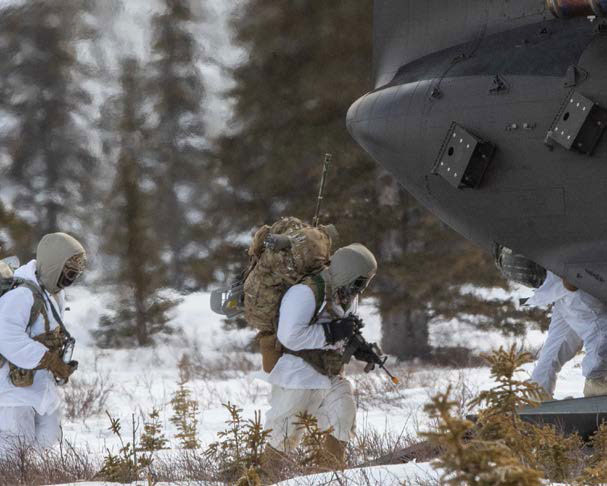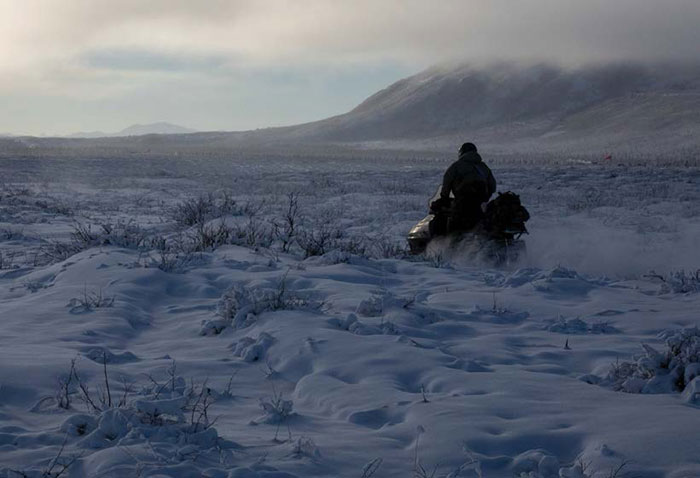Winter is Here: USAMRDC Charts Course for Army's Arctic Strategy

As the U.S. Army Medical Research and Development Command expands its already sizable medical research capabilities, it must continuously align with the U.S. Department of Defense's goals of expanding the Army's footprint, across any number of disciplines and locales. Nowhere is that quest for synergy seen more clearly than the Army's ongoing efforts to expand its capabilities in the Arctic; a heavy lift that puts the Command – specifically USAMRDC's Military Operational Medicine Research Program – at the very center of the entire endeavor.
"The environmental conditions in the Arctic present a unique set of physiological challenges," says Dr. Wayne Matheny, program area manager for MOMRP's Environmental Health and Protection Portfolio. "A number of problems associated with warfighter health and performance during Arctic operations need to be solved. Knowledge and materiel solutions that address issues related to injury prevention, injury management and warfighter performance are particularly important."
It's those very specific problems that MOMRP staffers hope to address in an upcoming Request for Proposal document – referred to officially as the "Military Prototype Advancement Initiative" – which was released on March 18th. This RFP, produced in conjunction with USAMRDC's partner the Medical Technology Enterprise Consortium, will likely be a substantial step towards delivering the solutions required to ensure Arctic dominance and sustainability for U.S. forces.
With average daily wintertime temperatures hovering around 30 degrees below zero, surviving and thriving in the Arctic's climate is the Army's chief concern. In addition – and as described in detail in the Army's recently-released Arctic strategy document entitled "Regaining Arctic Dominance: The U.S. Army in the Arctic" – the Army has specifically been tasked with the "materiel readiness" of Arctic-capable units to improve extended operations in the region. That means everything from machinery and weaponry to items as simple as the latex gloves that medical staff use to treat patients.

"The exam gloves currently used by medics operating in Role 1 scenarios – from the point of injury to the battalion aid station – are inadequate," says Matheny, a former Navy Special Amphibious Reconnaissance Corpsman who spent a decade at USAMRDC's U.S. Army Research Institute of Environmental Medicine before arriving at USAMRDC headquarters last year. "The extreme cold in the Arctic causes the gloves to become brittle and to break when donned to treat casualties."
That very request for climate-specific exam gloves was, in fact, a direct request from U.S. Army Alaska – a request which was woven into the RFP itself. Additional items addressed in the RFP include a focus on wearable technology (including a monitor capable of providing real-time core body temperature readouts to the wearer), technologies that can identify the severity of cold-induced tissue damage and efforts to identify unique individual variables (such as sex and skin blood flow control, among others) that could influence physiological susceptibility and responses in the cold.
It is, in short, an attempt to conquer a harsh, unforgiving tract of land from a number of angles.
"Gaining and sustaining an edge in the Arctic is key, and we need to use science and technology to push for greater physiologic capabilities in preparation for future conflicts," says Cmdr. Christopher Steele, MOMRP Director.
To that end, and as noted in both the RFP and the "Regaining Arctic Dominance" document, the physiological mechanisms that underlie susceptibility to cold injury are not yet fully understood, though – clearly – the identification of these factors will be key to determining optimal operational capacity of personnel for cold-weather operations. In other words – or, more specifically in the words of Matheny, who's academic and professional background is in musculoskeletal injuries – the prevention of cold weather injuries (such as frostbite) is at the root of the Arctic mission and, more immediately, the new RFP.
For the team at MOMRP, it's a chance to help chart the future of a new, substantial and strategically integral endeavor.














